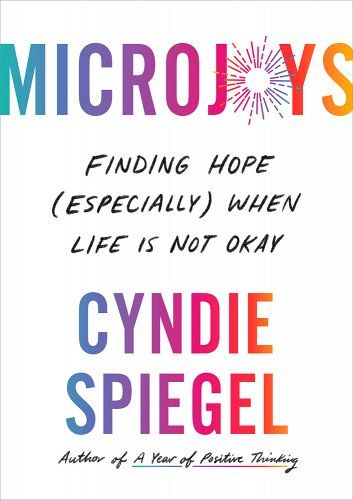If You're One of the Millions Who Are Uneasy Right Now, This Author Says Having a "Microjoy" Practice Can Help You Stay Hopeful
“Though life may be fleeting and fragile, it is equally stunning and profound in its precariousness,” writes Cyndie Spiegel in her new book, Microjoys: Finding Hope (Especially) When Life Is Not Okay. This quote may be the best summary of Spiegel’s book. The storyteller has encapsulated one of the hardest-to-grasp realities: that darkness, grief, and pain can coexist with beauty, light, and joy.
In Microjoys, Spiegel helps us answer an urgent question: How can we remain hopeful in the face of hardship and difficulty? In her attempt to answer this, she shares what helped her during a harrowing time—a year when her mother and young nephew died, she was diagnosed with cancer, and her brother fell ill. She leaned into what she calls “microjoys,” a way of being that allows you to see life’s complexities and beauty, and our human expansiveness. “It’s really about honing the ability to access joy, despite all else,” she tells The Sunday Paper.
We sat with Spiegel over Zoom to learn more about Microjoys and how this “lens,” as she refers to it, can provide a buoy in the darkest of days.
A CONVERSATION WITH CYNDIE SPIEGEL
The personal stories that you share in your book are raw. One of the throughlines is that many things can coexist at once—pain and beauty, joy and darkness. Will you talk about this?
I’ve known from a very young age that life is not linear. It’s not black and white. Part of this was taught to me by my mom. But also, being a black and white woman who's Jewish, I think I've always had this sense that there was no absolute right way. Then when the last few years happened, it's like this all bubbled up. The world has become so divisive. So many of us are in this place of choosing one right way. This all became a reminder of what I knew. And after my nephew was killed, it slowly started to come back to me. There is so much nuance in life. At any moment, all things can be true.
You write that once we journey the depth of loss comes our capacity to seize every experience differently. What do you mean by this?
I tried to be mindful of my words because I don't want anything in the book to be misinterpreted as a silver lining. I'm not glad these things happened because this great thing happened right afterward. No. But life is beautiful because of all of it, even without there being any silver lining.
There’s one line in the book where I talk about asking God to please make it all stop. We know that feeling. In some ways, it's like all we can do is go up—or somewhere—from here. I don't know if it's linear, but things will get better. That’s the precariousness. We never know where we will be, from day to day and moment to moment. But all of it holistically is incredibly beautiful and incredibly temporary.
So walk us through your concept of microjoys.
It’s about honing the ability to access joy in spite of everything else. It’s not one thing. It's a mindset and a way of moving through the world that we are constantly honing before or during difficult times. It’s a lens that I now see the world through that allows me to tap into this depth of joy—in so many different ways.
You differentiate microjoys from happiness. Why?
To me, happiness is quite external—and we live in a culture that chases it. Happiness can almost be like climbing a mountain that we never get to the top of.
A microjoy is a lens that we see the world through. It’s who we are.
Microjoys also lend us a reprieve, you believe. Considering that we’re living through intense and hard times, what if it’s too hard to feel this reprieve when there’s so much pain?
These streets are hard, particularly now. In our lifetime, we’ve never lived through a time that is as divisive as right now. Many of us, including myself, often feel stuck between the two. We think: Should I be looking for joy or experiencing joy when black folks are dying? When people in this country can't live and when women [in other parts of the world] can’t study? It's hard to hold those two things. The way I allow myself these moments of reprieve and microjoys is that if we don’t, we will become hardened. These moments of joy won’t change, cancel, or counter anything that's happening in the world. But we have to have these moments so we don’t get cynical.
It is only through the lens of finding joy, which is really at the core of the entire book, that we find hope. It is only through that that we can do the work that needs to be done to hopefully make this world a better place.
How can we start to practice microjoys?
After my nephew, Little Bobby was killed, I remember thinking, all I can focus on right now are the good times with him. So I keep this picture of him around. It was about what I had right then, in the moment. I remember digging through pictures—of his kindergarten outfit, of his missing tooth—and allowing myself to be transported. It was about choosing what I already had.
Sometimes we must go back to a moment of beauty, even if it feels forced. I don’t want people to feel they have to go out and find the thing. Many times, it's not out there anyway. Choose what you have. Start from where you are. Use memories that are in your bank.
Another thing I recommend is to become hyper-present at any moment and look exactly at what's around you. There’s an exercise called the 5-4-3-2-1 Method that uses all five senses. You focus on five things you can see and name them. Then you focus on four things you can touch and tell yourself out loud what they feel like. I’m touching a wooden desktop and it feels hard. I'm touching my jeans and they feel stiff. Next, you notice three things that you hear and repeat them out loud. Then you notice two things you can smell, and one thing you can taste. What I love about that exercise is that it's a tool to bring you right back. During difficult times, sometimes we focus on every bad thing that has happened. It’s a matter of grounding and coming back into the moment. You can start there and then see what joyful memories you can bring up.
[Editor’s note. You can learn more about the 5-4-3-2-1 Method here.]
Talking about memories, you love documenting things and taking photos on your phone, which you talk about in your essays. How can this play an important role in conjuring microjoys?
I’m a non-photographer but I have thousands of pictures on my phone. Most of them are not anything that I would show on Instagram or share. They’re just day-to-day things, like the color of my coffee with cream, my fresh manicure, and my cats playing. I documented everything.
When I sat to write the book, I realized how much of that became the basis for these essays about microjoys. These photos transport me back. I’m a visual learner, so it was a very organic way of taking in the world. We’re so busy all the time and it's so easy to miss things. I’m aware of how beautiful or unique something is, but I'm also very aware that I'm continuing to move during it. So I will take a picture of something now, thinking that I can come back to it, say on a Saturday morning when I’m drinking my coffee.
So documenting these moments is important. And it doesn’t have to be photography. It can also be in a journal. That becomes our bank of microjoys, so when we need them, we don't have to reach too far to access them. They’re all right there.

Cyndie Spiegel is a storyteller, speaker, and writer who uses her voice to ignite conversations around self-acceptance, integrity, and joy. She is a former fashion executive and adjunct professor at Parsons School of Design and Fashion Institute of Technology, as well as the founder of Dear Grown Ass Women, an inclusive social community for women 35+. She is the author of A Year of Positive Thinking and Microjoys: Finding Hope (Especially) When Life Is Not Okay, which you can order here.
Question from the Editor: What's one way you can start a microjoy practice today? We'd love to hear in the conversation below!
Please note that we may receive affiliate commissions from the sales of linked products.



